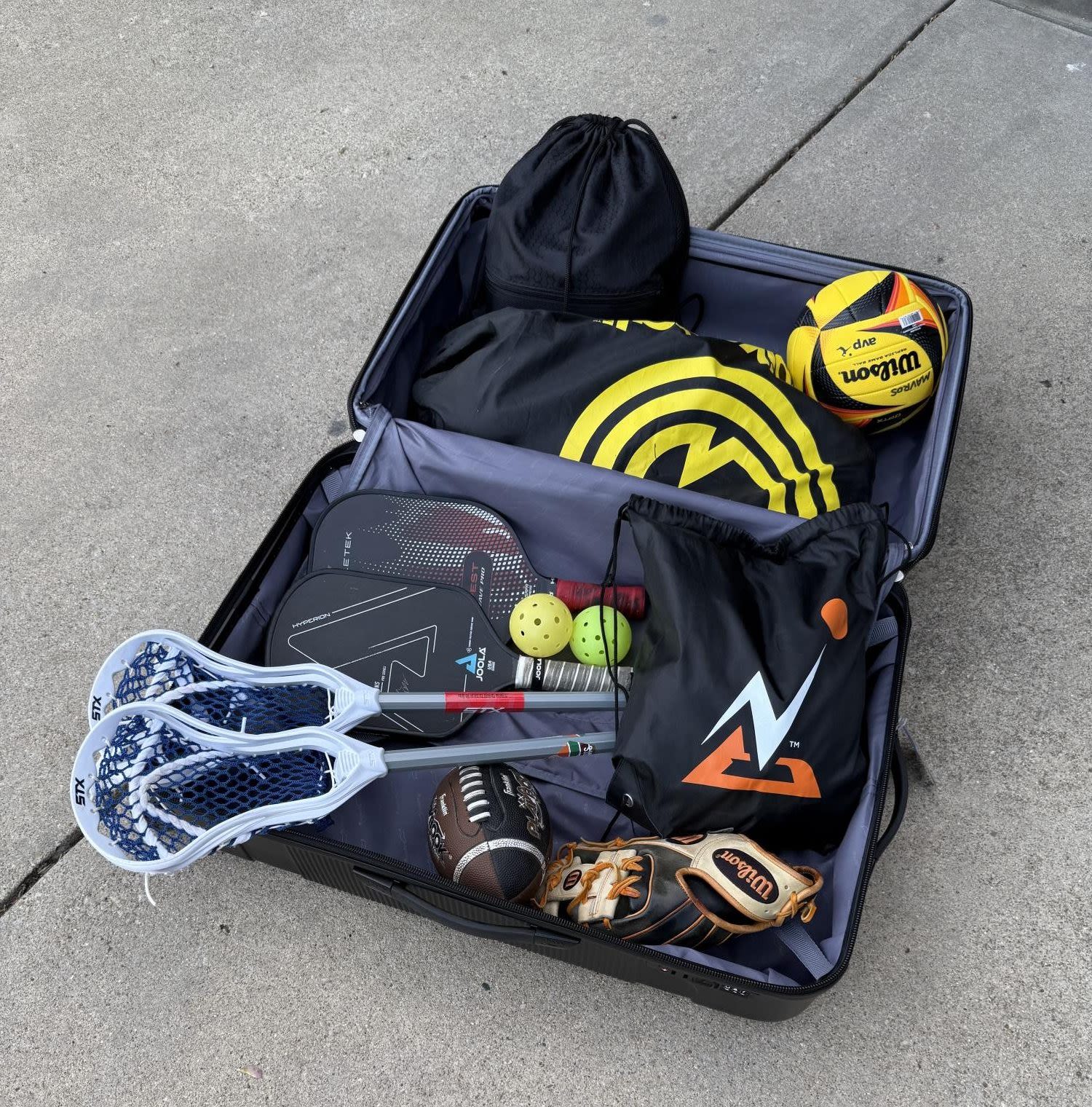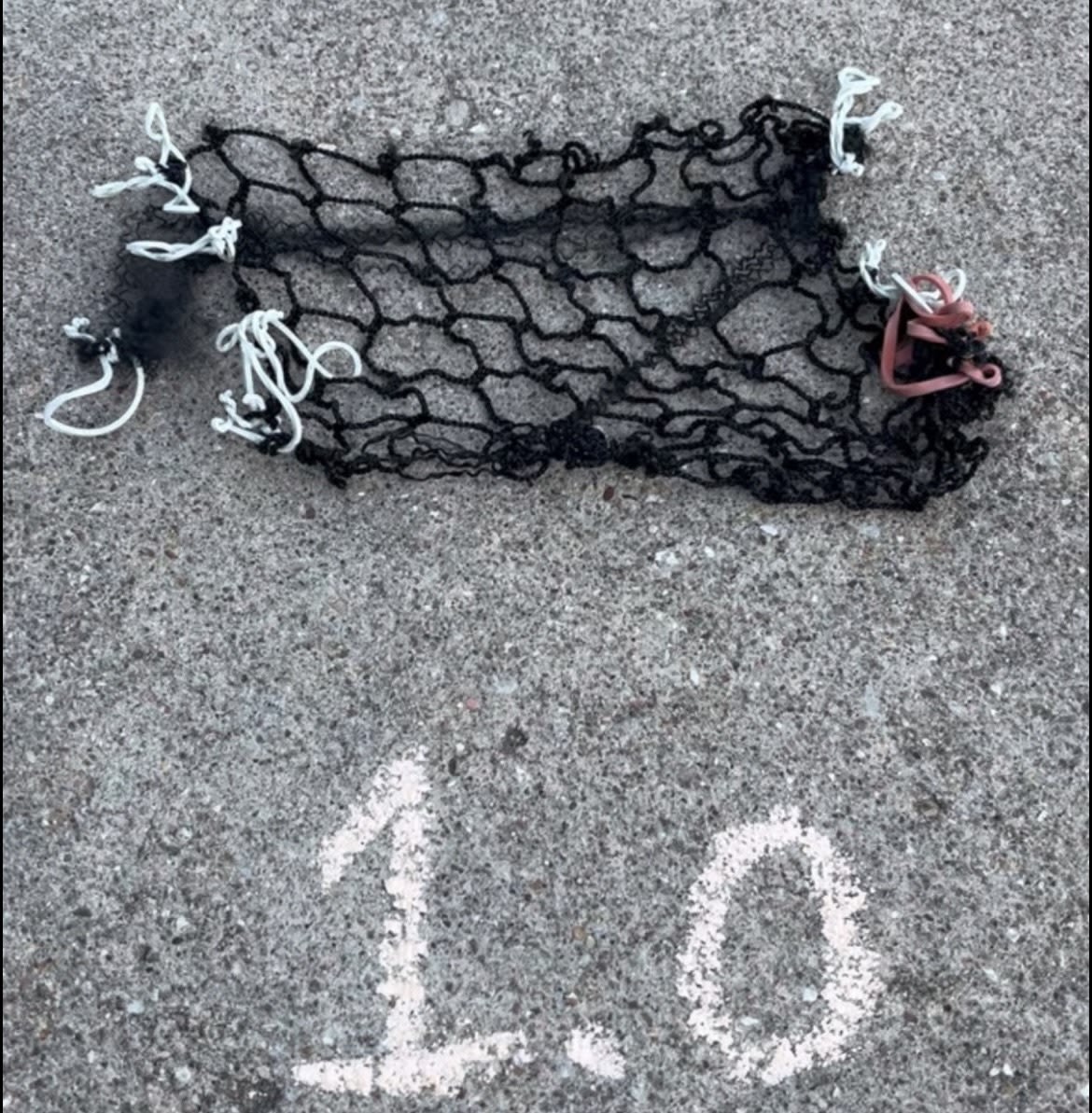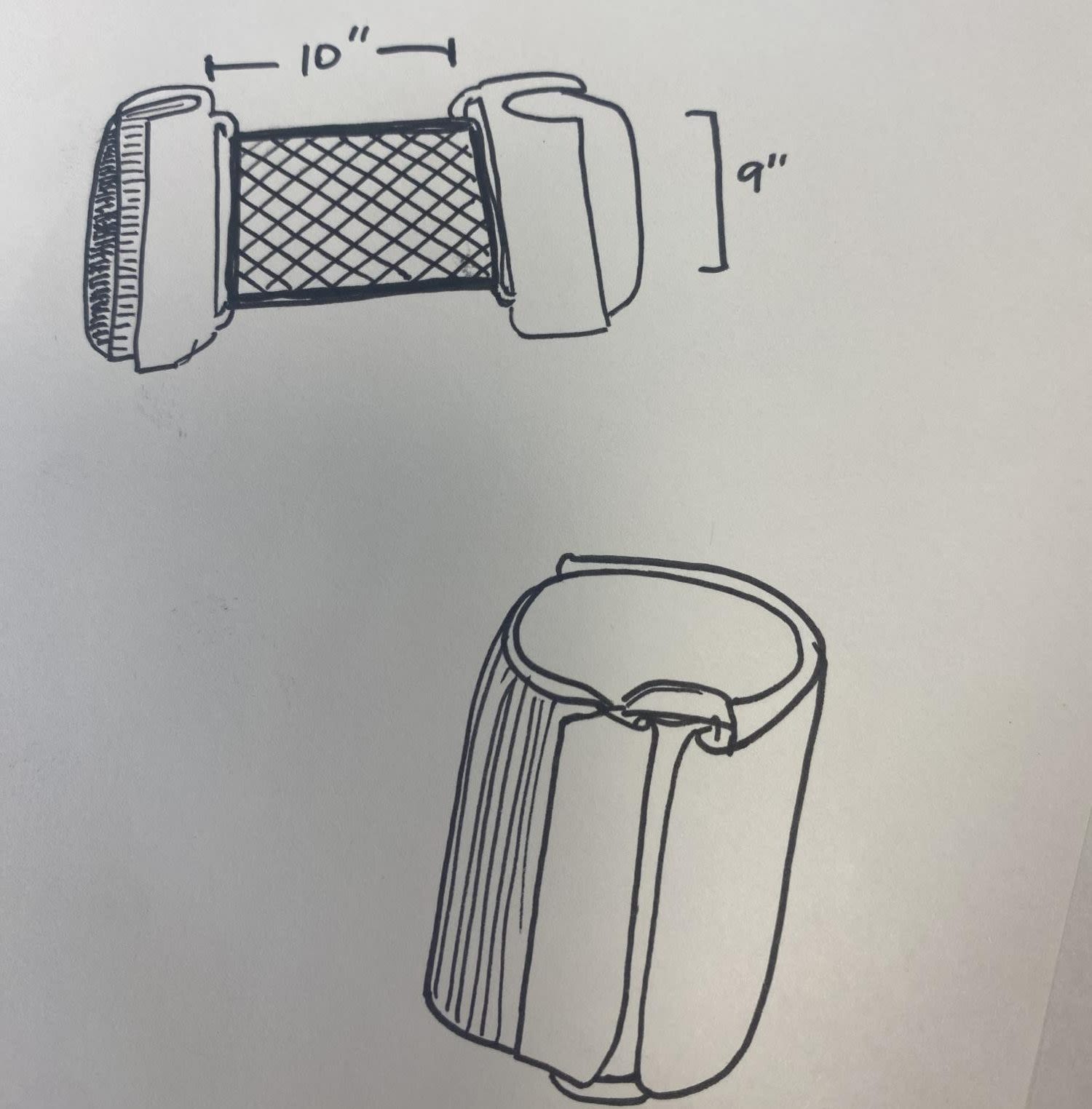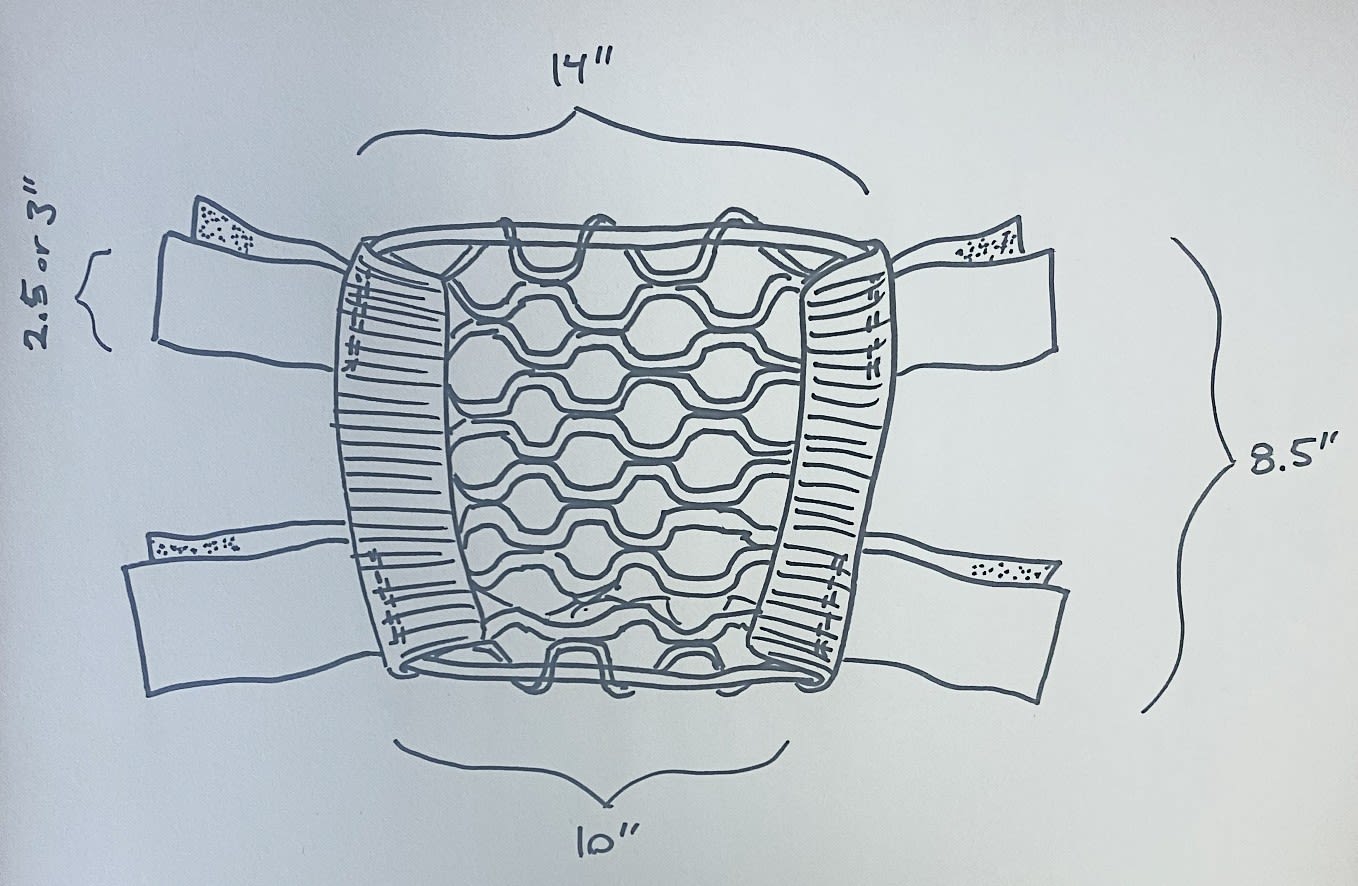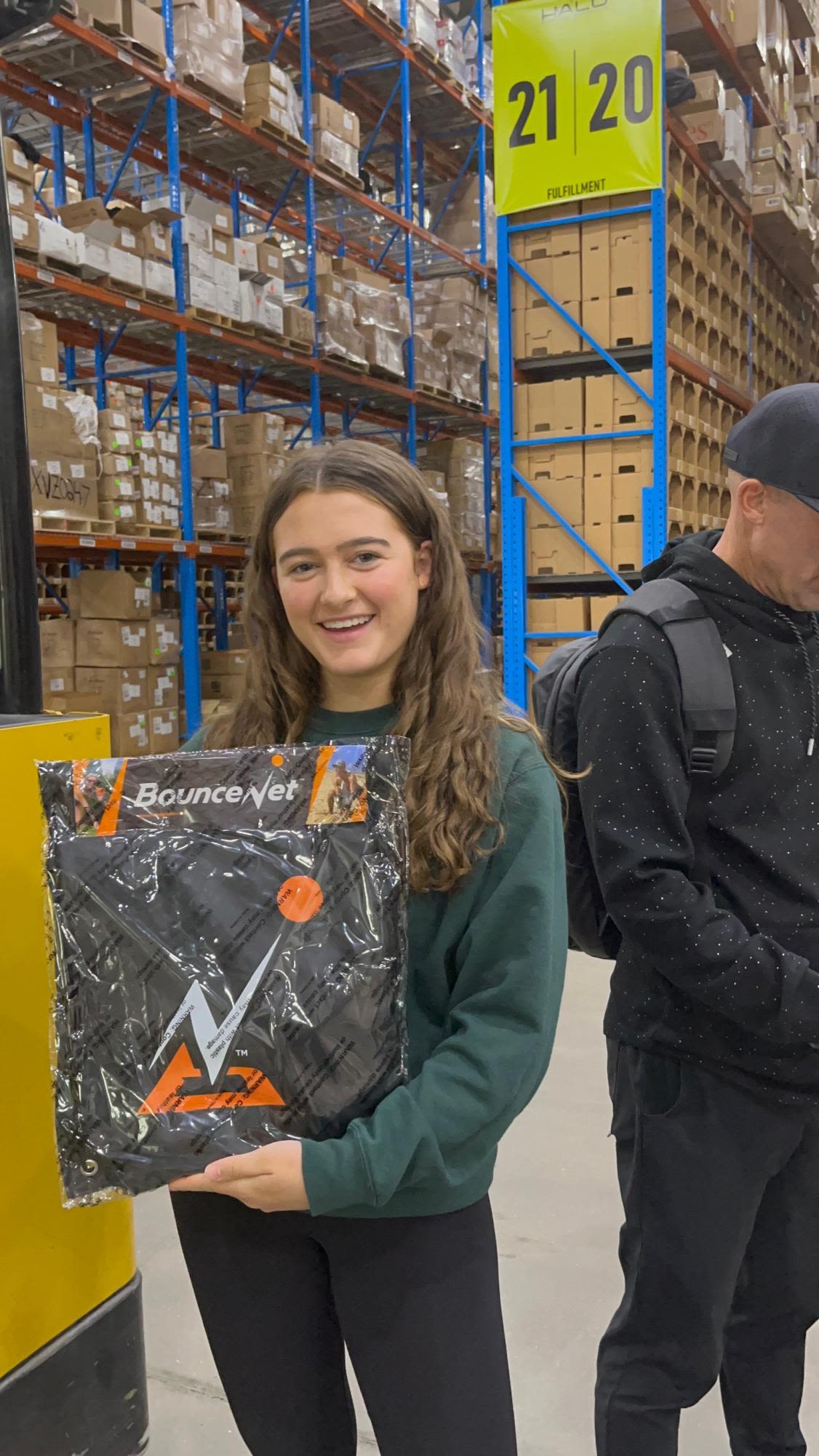BounceNet’s big break: the backyard game that built a bond—and a PE hit
What began as a spring break sketch became a reality—and deepened the bond between an inventive father and the daughter who supported the dream
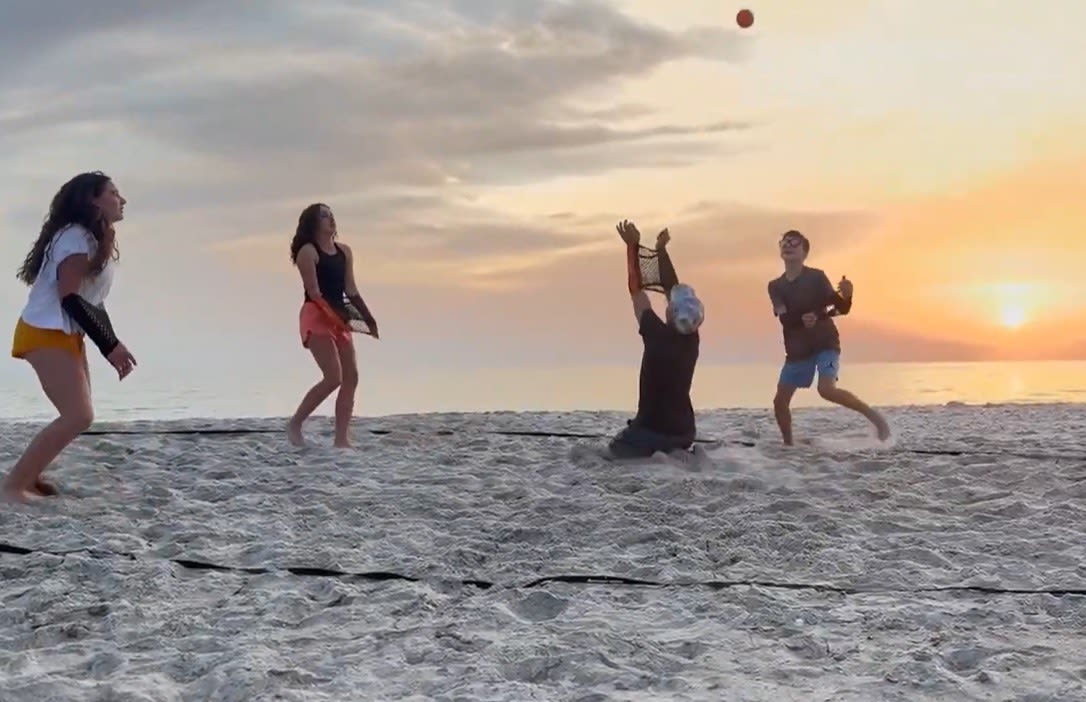
Every spring break when the Mavros family flies down to Florida, they check one very specific piece of luggage. It’s less of a suitcase and more of a mobile rec center—fuel for nonstop family competition and beachside fun. Photo Courtesy of: Jeff Mavros
Every spring break when the Mavros family flies down to Florida, they check one very specific piece of luggage. It’s less of a suitcase and more of a mobile rec center—fuel for nonstop family competition and beachside fun. Photo Courtesy of: Jeff Mavros
When Jeff Mavros packed for his family’s annual spring break trip to Florida, he didn’t just stow sunscreen and swimsuits in his suitcase. The family’s luggage included something a little heavier than your average beach gear.
Tagging along on the trip south was a suitcase crammed with pickleball paddles, baseball mitts, lacrosse sticks, Spikeball nets and whatever new game Jeff, the father of two Community students, had most recently added to the mix.
In 2023, Ella, Jeff’s sophomore daughter said, the bag “was like 50 pounds”—“all games.”
“We always play games on spring break,” Jeff said. “That’s our thing.”
From Spikeball to Hunnyball, the Mavros family didn’t waste a moment diving into friendly–but fierce–competition. Amid the usual chaos of deflated balls and game rule debates, something unexpected happened—an idea took root.
For the past 27 years, Ella Mavros' mother, Katie, and her family have been vacationing in the same location in Florida. When she married Jeff and had children, (left to right: Lily, Niko and Ella), the annual trip became a Mavros family tradition as well. Photo Courtesy of: Jeff Mavros
For the past 27 years, Ella Mavros' mother, Katie, and her family have been vacationing in the same location in Florida. When she married Jeff and had children, (left to right: Lily, Niko and Ella), the annual trip became a Mavros family tradition as well. Photo Courtesy of: Jeff Mavros
The trip did more than kick off beachside tournaments—it sparked an idea that would lead to the family’s own invention.
Somewhere between checking luggage, gate connections and pretzel packets, Jeff started sketching—trying to reverse engineer what made his favorite games work. The pages filled with fragments of family beach days, backyard laughter and a desire to build something lasting, something joyful.
“I [thought to myself] I’d like to make my own game,” Jeff said, one “that is really fun and can engage people in the same way.”
By the time the plane touched down on the tarmac, he had committed to turning that idea into something real.
“I was ready to get after it,” he said. “The second I thought, ‘I’m going to do this,’ I just started.”
But while Jeff, Illinois State University’s Executive Director of Admissions, had the creative drive, he didn’t pretend to have all the answers.
The journey from concept to creation wasn’t exactly smooth. For months, Jeff juggled design ideas–so many concepts, two years later, he’s forgotten them.
They weren’t really worth remembering anyways, Jeff said. “They weren’t good.”
His built-in test group—his wife and three kids—were never shy with feedback.
“For the first probably two weeks, I kept coming up with ideas and bouncing [them] off my kids and my wife,” Jeff said. “And the beautiful thing is, they had no problem telling me my ideas were terrible.”
Ella didn’t sugarcoat it either, Jeff said, she was often the first to say, “‘No way, this is dumb.’”
One idea, though, stood out—and Ella noticed.
“He had come up with a few other ideas before, and they didn’t really stick,” she said. “But [when] he came up with this one… I could see [it] becoming something.”
The result of his efforts would become BounceNet—a fast-paced, no-net, no-pole twist on volleyball.
Something a little easier to transport on an airplane, a little quicker to set up than Spikeball, BounceNet swaps the traditional court setup for a wearable mesh sleeve, where players bounce a smaller ball off their forearms in rapid-fire rallies.
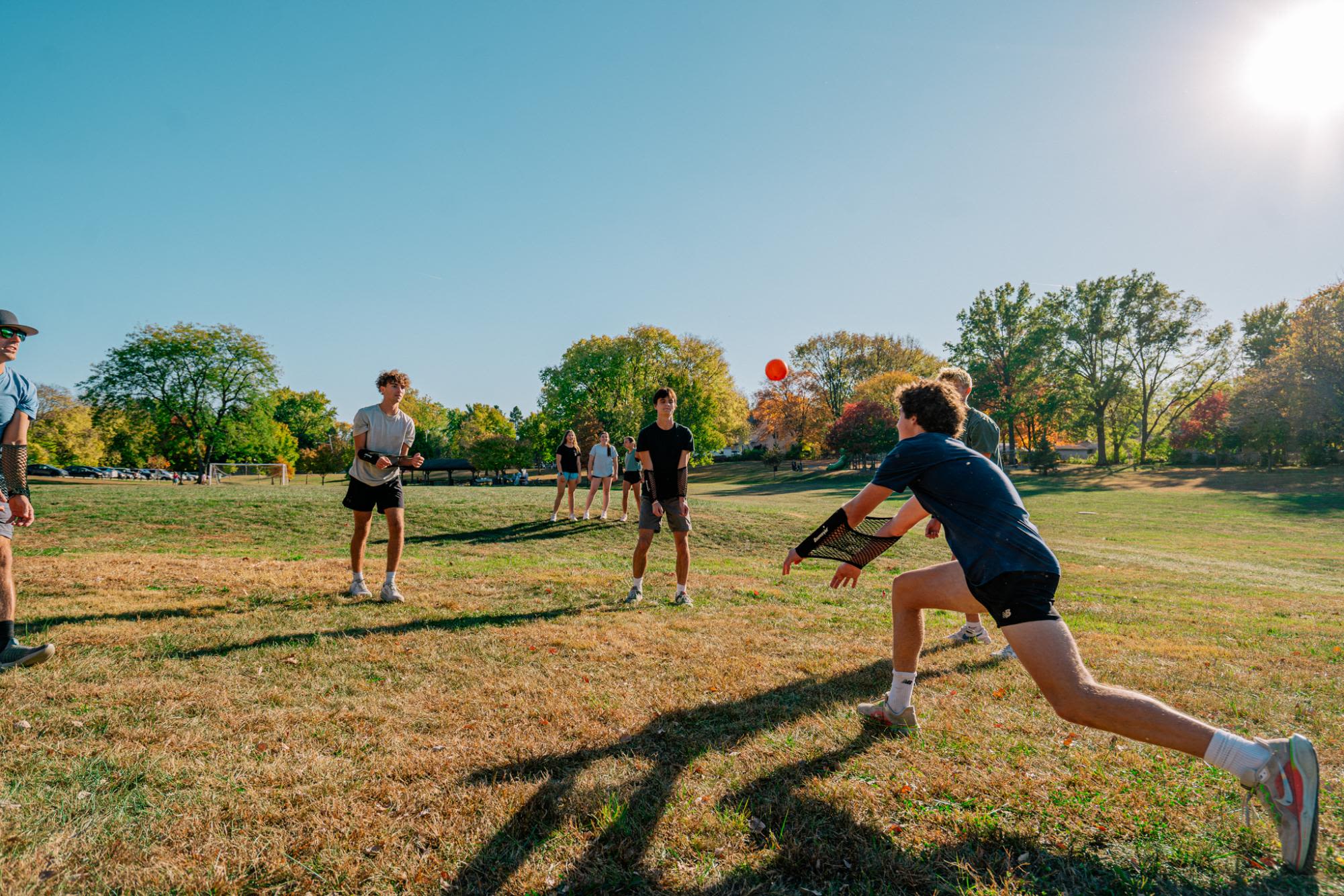
The game, Jeff said, “is unique,” it’s “novel. It’s new, and yet it has elements of something that’s really familiar to you. The best products are the ones that are new… but don’t need a ton of explanation because they remind us of something.”
The Mavros family didn’t waste time. Their first prototype was pure DIY: a shredded Spikeball net, a few rubber bands and two wrists willing to give it a go.
“Right then I was like ‘this is really cool,’” Ella said. “I had some volleyball experience so I was really into it.”
From there, Jeff went all-in on perfecting the design. That meant dozens of versions, extensive material testing and a half a year of iteration after iteration–and frustration.
“For the first, gosh, it was probably a six-month process,” he said. “We went through like 11 different designs to get the sleeve right.”
Ella was a constant as Jeff tried to work through the variables, helping test version after version.
“Sometimes I’d be in the middle of homework,” Ella said, “and he’d text me, ‘Hey, sleeves are in.’ So I’d go down and try it with him.”
Homework paused, she'd head downstairs to test the latest model—just her, her dad and a ball flying back and forth in the basement–rallies which became something more than just trial runs.
Ella wasn’t just playing the game, but shaping it—offering feedback and making decisions, Jeff said.
His teenage daughter became his “sounding board.”
Jeff leaned on his network to bring his idea to life—connecting through an Illinois State University alum, he partnered with a promotional products company that transformed his early sketches into the first real working prototypes. Photos Courtesy of: Jeff Mavros
Jeff leaned on his network to bring his idea to life—connecting through an Illinois State University alum, he partnered with a promotional products company that transformed his early sketches into the first real working prototypes. Photos Courtesy of: Jeff Mavros
And he’d need one—because turning an idea into a shelf-ready, finished product was anything but simple. Finding the right manufacturing partner, in particular, became a saga of its own.
“You will kiss so many frogs to find your prince,” Jeff said. “If I had any hair, I’d pull it out.”
He credits much of the project’s growth to outside guidance, including the mentorship of a product development firm that helps independent inventors take their ideas from concept to market and support from colleagues at Illinois State.
“I’ve only gotten to where I’ve gotten because of so many other people,” Jeff said.
Like the games that inspired it, the development of BounceNet was the product of teamwork.
He even reached out to the creators of one of the family’s vacation staples, Hunnyball, a fast-paced, team-based game often described as “the most competitive game of catch on Earth,” asking for guidance.
As the family tested more versions, BounceNet evolved from a living room prototype to a product ready for a bigger stage–Ella’s PE class full of curious Ironmen.
Ella wasn’t just a tester anymore—she became BounceNet’s unofficial ambassador.
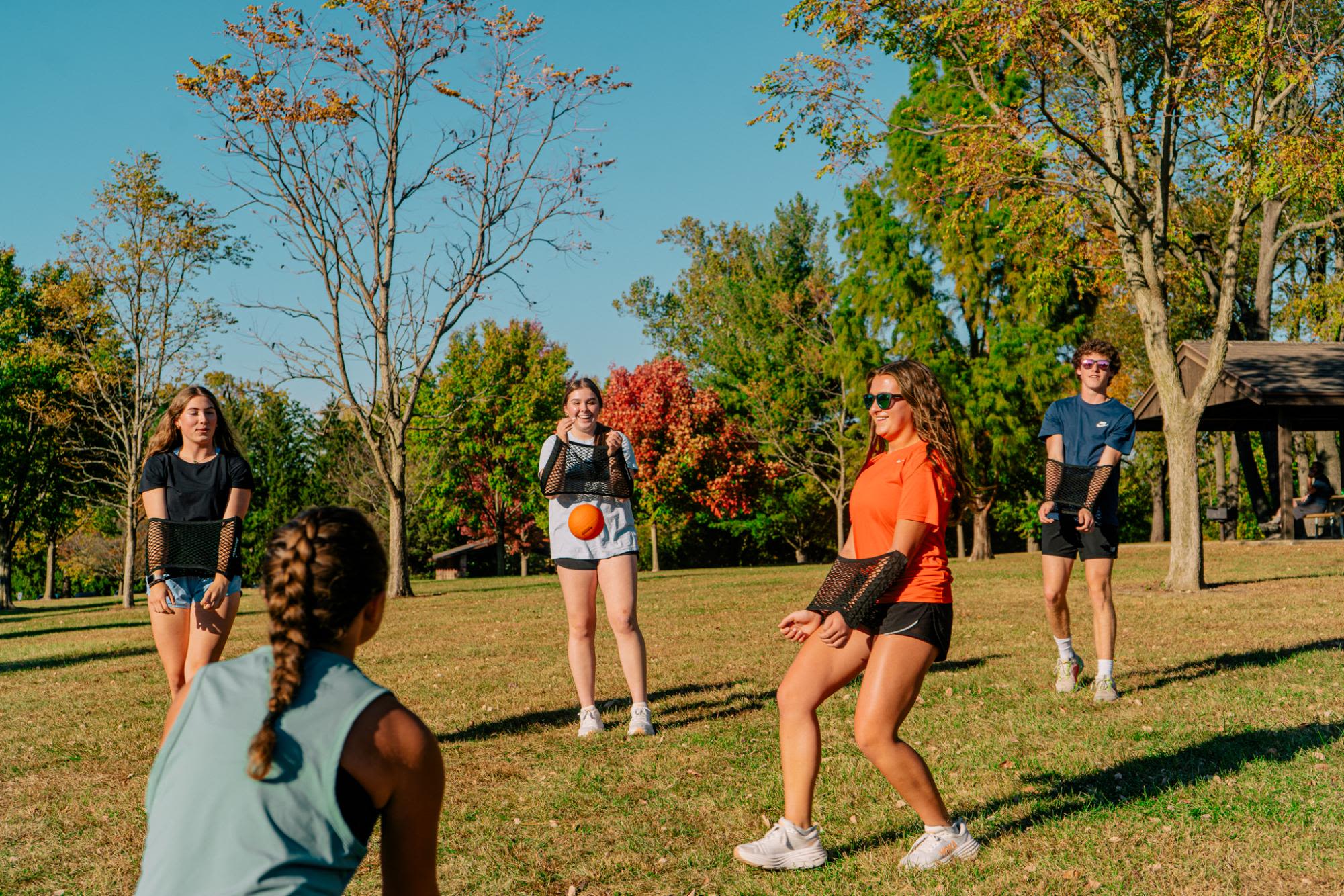
She rounded up athletic friends for park demos and photoshoots, brought the game into classrooms and hallways and watched teachers do double takes.
On a free day in PE, Ella brought in a set and casually introduced the game to her classmates. It didn’t stay under the radar for long.
“‘What is this?’” Ella said, recalling the moment PE department chair Mrs. Mindy Ewalt first saw the game in action.
“I said, ‘That’s my dad’s game.’”
Ewalt’s reaction: “I need this.”
Ella remembers another enthusiastic reaction, that of PE teacher Mr. Jacob Wegner.
“He saw it, he was like, ‘this is really cool,’” Ella said. “He started playing with us, and he immediately [asked], ‘Can I invest in this?’”
Wegner didn’t cut a check, but he did something better—he got BounceNet into students’ hands. Within weeks, the department had ordered 60 sets, enough for two classes to use simultaneously, planning for a full PE rollout.
“They were really positive on all of the benefits that [it] could bring to a PE unit,” Jeff said.
Behind the scenes, Jeff had already been in conversations with staff about how the game might serve different student populations.
“We had a really positive meeting where we all talked about what this could be for PE units,” he said, “how it translates for students of different abilities, and the different ways it can be applied to volleyball… maybe even as a precursor to the volleyball unit.”
To Wegner, its flexibility is one of BounceNet’s biggest strengths.
“It could be a separate sport, or it could be an assistant, an aide in another sport like volleyball,” he said. “That’s why I believe it can be beneficial in multiple aspects.”
The PE staff aren’t the only ones who see the value in the mechanics.
“There’s a youth volleyball coach that we know well that has told us how much she loves it as almost like a volleyball training tool,” Jeff said. “The body positioning” is “just the way they try to coach players to pass the ball.”
On April 1, Jeff came to Community—not to watch from the sidelines as a parent, but a guest instructor. He introduced BounceNet to classes all day long.
“At Normal Community [that was] probably about the largest group that we’ve had it in front of at one time. So it was fun,” he said.
Outside the school walls, BounceNet made its official market debut in November—and it got off to a hot start.
“We reached states like Florida, New York, New Jersey, Utah, Missouri, Arizona, Louisiana, Colorado and Philadelphia,” Mavros said.
He’s also connecting with retailers—including a pickleball shop owner in Naples, Florida—who plan to stock the game.
“I play a lot of pickleball myself,” Jeff said. “He’s going to start carrying some sets for me down in Naples.”
But the Mavros family isn’t don’t tinkering with the concept.
The next version of the game, a four-to-six-person set with expanded rules, is just a couple months away.
“I believe it’ll be big,” Jeff said. “But the first step is just getting it into practice in the school setting. There are other applications, though—for college kids on the quad, at the beach, for spring break. There’s lots of potential.”
For Jeff, the vision is as much about connection as it is about competition.
“I really wanted to create something that would put something positive out into the world,” he said, “and hopefully would bring people together for just simple fun and to have young people put down their devices.”
The game may have started as a side project,—something Jeff spent his hours before and after work toying around with—but somewhere between the late-night toiling and driveway test sessions, it became something more.
His “labor of love,” designed to bring others together, helped bring the Mavros family together.
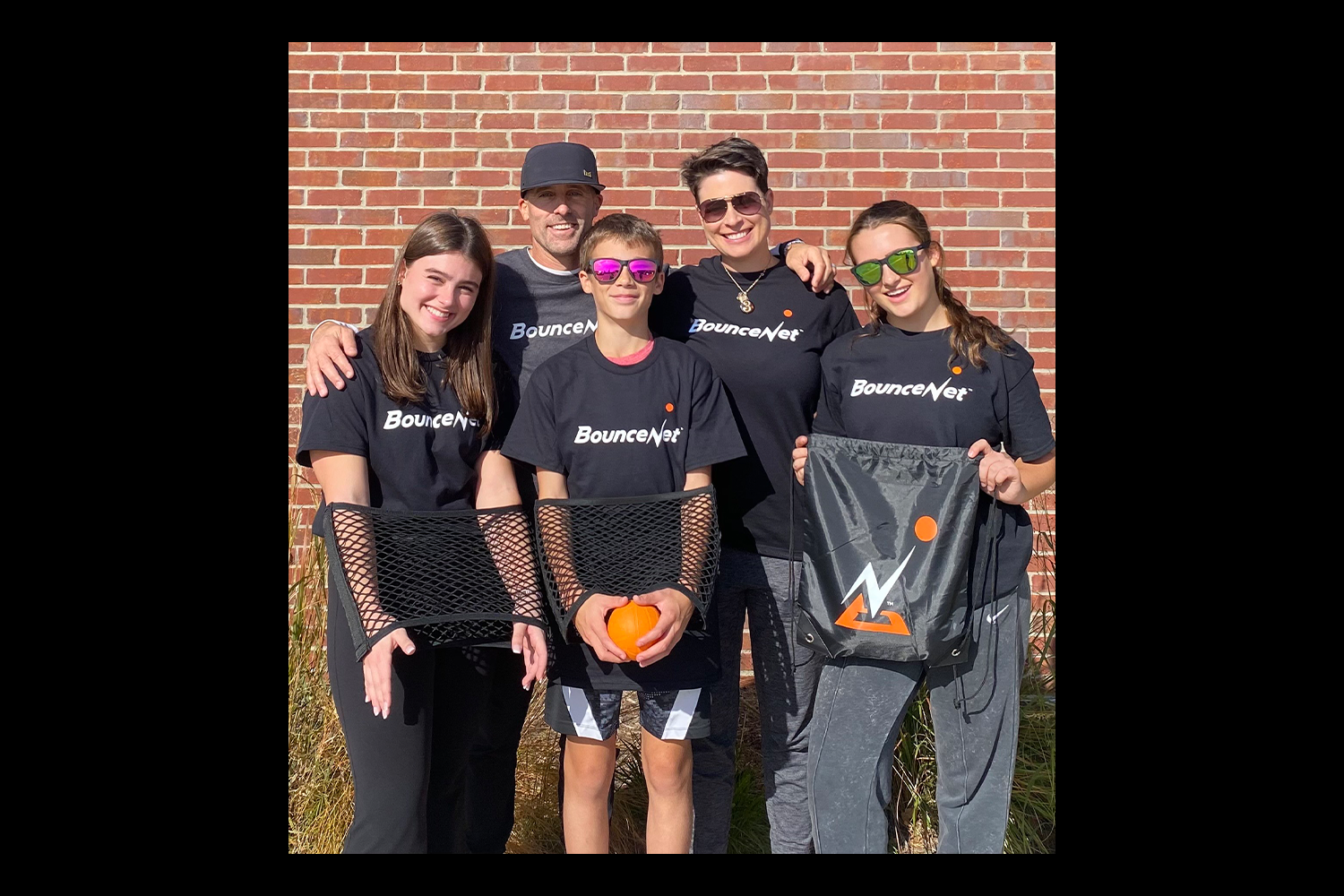
“I never envisioned that this would be something the whole family would rally around,” Jeff said. “But Ella stepped forward and said, ‘I want to be part of this.’ That’s been the coolest part—doing this together.”
While Jeff leaned on industry experts, university connections and months of trial and error to bring his backyard game to life, it was Ella who stood beside him every step of the way.
From warehouse visits to product design brainstorms, Ella didn’t just support the project—she was essential on the long road from prototype to production.
“My entire family has been incredibly supportive,” Jeff said, “but Ella has been almost like a business partner to me, where she's she's back at every turn.”
“Hopefully it will be a part of my life for many years to come,” he said. “I hope it becomes an even bigger part of my life.”
His long-term goal is simple. He isn’t chasing corporate deals or viral fame. His dream is quieter, and a little poetic: to one day stumble across a group of strangers in a park, bopping a ball between mesh sleeves, laughing the way his family did.
“That would be like the coolest thing,” he said.
Cradling one of the first finished BounceNet packages, Ella Mavros holds more than just a product—she holds a piece of a journey she’s been part of from the start. Photo Courtesy of: Jeff Mavros
Cradling one of the first finished BounceNet packages, Ella Mavros holds more than just a product—she holds a piece of a journey she’s been part of from the start. Photo Courtesy of: Jeff Mavros

